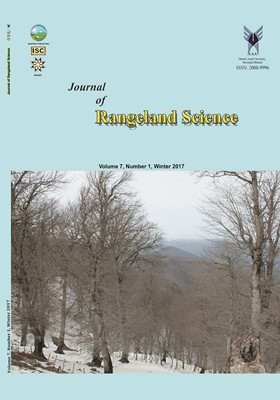The Effects of Deferred Grazing System on Vegetation Parameters in Semi-Arid Rangelands (Case Study: Jashlubar, Semnan, Iran)
محورهای موضوعی : Relationship between Animal and RangelandMojgansadat Azimi 1 , Moslem Mozafari 2
1 - Assistant Professor, Faculty of Rangeland and Watershed Management, Gorgan University of Agricultural Sciences and Natural Resources, Golestan, Iran
2 - The center of agriculture and natural resources research and education of Semnan province, Semnan, Iran
کلید واژه: Forage production, Vegetation cover, Rangeland management, Grazing system, Delayed grazing treatment,
چکیده مقاله :
Rangeland management plan is one of the major means of management and utilization of rangelands in Iran. The formulation of these plans for the rangeland users should be studied from the ecological and socio-economic points of view. One of the main envisaged activities in almost all the management plans is the grazing system. An experiment was used to study the effects of three deferred grazing systems (15, 30, 45 days delay) and control treatment (Non- grazed) on vegetation parameters in semi-arid rangelands of Jashlubar in Semnan province. The experiment was conducted using a completely randomized block design (RCBD) with three replications over 6 years (2006-2011). In each experimental unit, data from three life forms of vegetation (shrub, forbs and grasses) were collected along a 30 m transect within ten fixed quadrates (0.5 × 0.6 m2) appropriate to vegetation sizes. In addition, forage productions of two life forms (forbs and grasses) were collected over 5 years. Data were analyzed using SAS software and means comparison was made based on Duncan’s method. The results showed the significant effects of deferred grazing systems on the growth of shrubs in terms of canopy cover. However, there were no significant differences between treatments for canopy cover percent of forbs and grasses. The lowest shrub canopy cover was obtained in 45-day delay of grazing. There were also significant effects of deferred grazing systems (15, 30 and 45 days delay) on forage production of both forbs and grasses (P<0.05). Result of means comparison showed that the best delay time for the rangeland utilization of this area considering the annual precipitation is the 15-day delay with the highest forage production for forbs and grasses and the highest cover percent for shrubs.
Adams, B.W., 1992. Grazing Systems for Public Rangelands. Range Note Issue 10. Alberta Forestry Lands and Wildlife. 11 pp.
Alizadeh, M., Mahdavi, M., Jouri, M.H., 2010. Capability investigation of carbon sequestration in two species (Artemisia sieberi Besser and Stipa barbata Desf) under different treatments of vegetation management (Saveh, Iran). Jour. World Academy of Science, Engineering and Technology 70, 295-298.
Asner, G.P., Elmore, A.J., Olander, L.P., Martin, R.E. and Harris, A.T., 2004. Grazing systems, ecosystem responses, and global change. Annual Review of Environment and Resources.29: 261-299.
Assareh, M.H., Akhlaghi, S.J.S. 2009. Strategic framework for developing and promoting natural resources research in I.R. Iran. Iranian Research Institute of Forest and Rangelands. 379 p. (In Persian)
Azimi, M., Heshmati, G. A., Farahpour, M., Faramarzi, M., and Abbaspour, K. C., 2013. Modeling the impact of rangeland management on forage production of sagebrush species in arid and semi-arid regions of Iran. Jour. Ecological Modelling. 250, 1–14.
Badripour. H., 2006. Review of Rangeland of Iran. Rangeland Management Expert in the Technical Bureau of Rangeland. Forest, Rangeland and Watershed Management Organization (FRWO). Ministry of Jihade-Agriculture, Iran.110 pp.
Bailey, A.W. 2008. Prescription grazing for brush management in Canadian aspen parkland, foothills and lower boreal forest, Chapter 7. In: Moss, et al. A guide to integrated brush management on the Canadian plains. Manitoba Forage Council, Brandon.
Bailey, A. W., Mc Cartney, D., Schellenberg, M. P. 2010. Management of Canadian prairie rangeland. Agriculture and Agri-Food Canada. University of Alberta. PFRA. 66p.
Briske, D. D., Derner, J.D., Brown, J.R., Fuhlendorf, S.D., Teague, W.R., Havstad, K.M., Gillen, R.L., Ash, A.J., and Willms, W.D., 2008. Rotational grazing on rangelands: reconciliation of perceptions and experimental evidence. Rangeland Ecol. Manage. 61:3-17.
Fleming, W.D., Galt, D and Holechek, J., 2001. Ten steps to evaluate riparian health. The Rangelands Jour. 23(6):22-27.
FRWO (Forests, Iranian Rangeland and Watershed Organization). 1982. Code of rangeland plants species in Iran. 32 pp. (In Persian)
Grings, E.E., Short, R.E., Geary, T.W. and MacNeil, M.D., 2002. Heifer development within three seasons of calving. Proc. West. Sec. Amer. Soc. Anim. Sci.53:261-264.
Goldewijk, K. K., and Battjes, J. J., 1997. A Hundred year (1890-1990) database for integrated environmental assessments (HYDE, version 1.1). Report of National Institute of public health and environment (RIVM), Bilthoven, the Netherlands.
Harris, R. B., 2010. Rangeland degradation on the Qinghai-Tibetan plateau: A review of the evidence of its magnitude and causes. Jour. Arid Environments: 74: 1-12.
Holechek, J.L., Pieper, R.D., and Herbel, C.H., 2005. Range management, principles and practices, 5th. Edition. New Jersey: Pearson Education.
Karimi, Gh., Fayaz, M., Yeganeh, H., Nasri, M., Afrah, H., Safari, H., and Moameri, M., 2014. Assessing preference values of rangeland species of the central Alborz in Iran using multivariate techniques. Jour. Arid land research management. 23: 59-73
Li, C., Hao, X., Zhao, M., Han, G. and Willms, W.D. 2008. Influence of historic sheep grazing on vegetation and soil properties of a Desert Steppe in Inner Mongoila Agriculture. Jour. Ecosystem Environment. 128:109-116.
Mozafari, M., 2009. The final report of the evaluation of rangelands in Semnan. Research Institute of Forests and Rangelands in Iran, 145 p.(In Persian).
Reece, P. E., Schacht, W. H., Volesky, J. D., 2007. Skillful grazing management on semiarid rangelands. University of Nebraska-Lincoln. Extension Circular, EC162. 8p.
Sanadgol, A. A., and Moghadam, M. H., 2004. The effect of grazing systems and grazing intensities on standing crop and forage intake in Bromus tomentellus pasture. Jour. Pajouhesh and Sazandegi. 64: 30-35. (In Persian).
Squires, V. R., and Karami, E., 2015. Livestock management in the Arid zone: Coping strategies Jour. Rangeland science. 5(4):336-346
Vallentine, J.F., 2001. Grazing Management. Elsevier science. 2nd edition. 659 pp.


